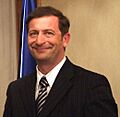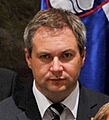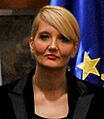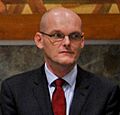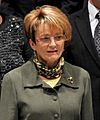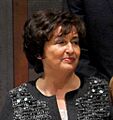12th Government of Slovenia facts for kids
Quick facts for kids Cerar cabinet |
|
|---|---|
12th Cabinet of Slovenia |
|
| Dissolved | |
 |
|
| Date formed | 18 September 2014 |
| Date dissolved | 13 September 2018 |
| People and organisations | |
| Head of state | Borut Pahor |
| Head of government | Prime Minister Miro Cerar (SMC) |
| Member party | Modern Centre Party (SMC) Democratic Party of Pensioners of Slovenia (DeSUS) Social Democrats (SD) Independent (Ind) |
| History | |
| Election(s) | 2014 election |
| Predecessor | Bratušek cabinet |
| Successor | Šarec cabinet |
The 12th Government of Slovenia was a team of leaders who ran the country of Slovenia. It was led by the Prime Minister, Miro Cerar. This government started its work on 18 September 2014. It was formed after the parliamentary election in 2014. In this election, the Party of Miro Cerar won the most votes.
Miro Cerar was 51 years old when he became Prime Minister. His team, or "cabinet," had a special record. It had the most women ministers ever in Slovenia's history at that time. Seven out of sixteen ministers were women! Also, many members of Cerar's cabinet had advanced university degrees. Six of them had a doctorate, which is a very high level of education.
After the previous government resigned, new elections were held on 13 July 2014. Miro Cerar's party won a very high percentage of votes. This was the highest percentage for any party in a parliamentary election since Slovenia became independent. Cerar's party decided to work with other parties to form a "coalition." A coalition is when different political parties agree to work together to lead the country. The first party to join was the Democratic Party of Pensioners of Slovenia (DeSUS). Then, the Social Democrats (SD) party also joined. These three parties signed an agreement to work together on 3 September 2014.
The members of the government came from these three parties:
- Party of Miro Cerar (SMC): 8 ministers and 1 minister without a specific department
- Democratic Party of Pensioners of Slovenia (DeSUS): 3 ministers and 1 minister without a specific department
- Social Democrats (SD): 3 ministers
- Independent (Ind): 1 minister
On 14 March 2018, Prime Minister Miro Cerar announced he was stepping down. This happened after a court decision about a public vote on a railway project.
Contents
How the Government Changed
The Cerar government made some changes to how ministries were set up. A ministry is like a big department that handles a specific area, like education or health.
- The number of ministries grew from 13 to 16.
- A new ministry was added. It was called the "Ministry without Portfolio responsible for Development, Strategic Projects and Cohesion." This ministry focused on planning for the future of the country.
- The role of "Vice President" of the government was brought back after 14 years. Miro Cerar named three Vice Presidents.
- The "Ministry of Interior and Public Administration" was split into two separate ministries: the Ministry of Interior and the Ministry of Public Administration.
- The "Minister of Infrastructure and Urban Planning" was also divided. It became the Ministry of Infrastructure and a new "Ministry of Environment and Spatial Planning."
Important Changes in Ministers
During its time, some ministers in the Cerar government changed. Here are a few examples:
Changes in Key Roles
- On 18 October 2014, the Minister of Economy, Jožef Petrovič, resigned. He left his job after only one month. He wanted the government to work peacefully. On 4 December 2014, Zdravko Počivalšek took his place.
- On 10 October 2014, Violeta Bulc, who was a minister without a specific department, was chosen for an important job in Brussels. She became a new European Commissioner for Transport. This meant she left her role in the Slovenian government. Alenka Smerkolj became the new minister for Development, Strategic Projects and Cohesion on 19 November 2014.
- On 6 March 2015, the Minister of Education, Science and Sport, Stanka Setnikar Cankar, resigned. After a short time, Klavdija Markež was appointed to the position on 30 March 2015.
- However, on 1 April 2015, Klavdija Markež also resigned. This was only five days after she started.
- On 25 April 2016, the Minister of Culture, Julijana Bizjak Mlakar, resigned. This happened because she disagreed with Prime Minister Cerar about how to manage the Idrija Mine.
Images for kids



